Kartik Purnima Mela (2006) at Janapao, Mhow (MP); India
Location: The hill of Janapao, Village: Rajpura Kuti, Approximately 15 kms from Mhow on the Agra Bombay Road as one drives towards Mumbai, Tehsil: Mhow. District Indore. State: Madhya Pradesh, India
The day: Kartik Purnima - the first full moon after Diwali. This year the day fell on November 5, Sunday. The temple of Janapao is famous for a mela which is held on Kartik Purnima every year. This is the best time for a mela. It is exactly a fortnight after Diwali. The weather at this time of the year is excellent. Not warm at all. Slightly cold. I have been visiting this hill temple every Kartik Purnima from 1994 onwards. It is a big day in my calendar. It is the day I get to see thousands of villagers from near and far come to this temple to pay obeisance to Lord Shiva and to bathe in the temple pond at the top of the hill.
Janapao, according to local legend, is the place where Jamadagni, the father of Parasurama, lived. As Parasurama, one of the avatars of Vishnu is connected with the mythology of Kerala - the state I originally belong to - I get an actual feel of how mythology connects different parts of India.
The hill of Janapao isn't very high but it isn't an easy hill to climb either. It is supposed to be the second highest hill on the Malwa Plateau. I have come here on normal days too. Sometimes alone and sometimes with groups of trekkers. But nothing equals what I see on Kartik Purnima day. It is an awe inspiring sight to see old men and women climb up the hill barefeet. It is amusing to see young men trying to go as high as possible on their motorbikes. I guess the very idea of a pilgrimage is defeated when one makes the act of reaching there an easy one. Something like going to Vaishno Devi by helicopter.
I drove down till village Kuti on the 5th. I would have preferred reaching there by bus or even by cycling down but social commitments ate up a few hours between breakfast and lunch. And so I had to turn to one of my regular cab drivers for help. Leaving the car at a safe place. I went up the hill. But before that I spent some time at the mela. Savouring the atmosphere and clicking a few pictures. A policeman on duty wanted to know which newspaper I represented. I told him that these pictures were for the internet. I am not sure whether he understood.
The climb up was tough. But the sight of young children and their old grandparents also climbing the same hill motivated me a lot. I was out of breath as I climbed up. But I have learnt how to pace myself. This seems to be something I am getting better at with each passing year.
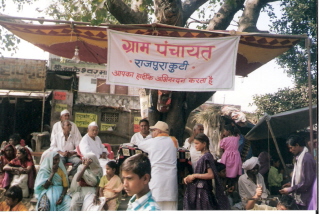
The village panchayat is out on this day. Arranging the mela with the help of policemen who have been assigned the job of enusring that the mela is held peacefully and the pilgrims complete their pilgrimage without any hitch.
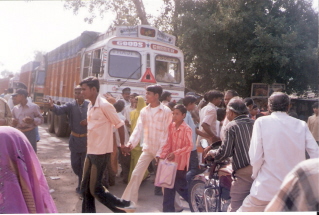
The stretch of the busy Agra Bombay road which passes through the village gets blocked. Trucks loaded with goods have to stop or crawl through the crowds.
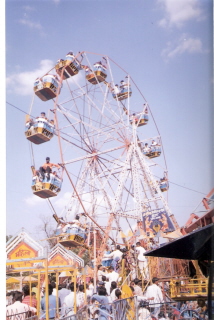
A mela without a giant wheel? No way! There is one here too.

One of the many shops selling tea and snacks. The ladoos and jalebis look tasty. But I'd rather not eat them. I go for the biscuits and tea. Much safer.
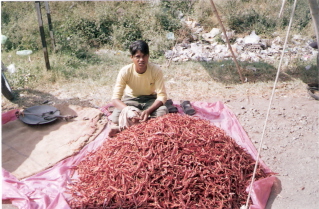
There are many vendors selling everything from chillies to combs. This young man is sitting with his pile of chillies. I forgot to ask him where he belongs to. In all probability he may have come from the plains of Nimar. Nimar is where the Narmada flows and is famous for the 'jwala mirchi' or 'fire chilly'.

I also see this young man advertising the berries he is selling. "Marwar ke bor" is what I hear him repeatedly saying in a loud voice. He tells me that these are from Marwar, Rajasthan. I remember the ber (berries) we used to pluck outside our house in Itarana Cantonment of the Alwar district of Rajasthan. I buy two rupees worth of ber. Their taste takes me back to my childhood. I continue walking.

Just before the main hill of Janapao is this temple dedicated to Hanuman. I see many villagers and pilgrims pay obeisance. I fold my hands and give my respects. But I do not stay back. I have started late today. It is near 3 pm. I must ascend, spend an hour on top and descend - all before it gets dark.

The climb begins. I have chosen the tougher of two paths. It is an annual ritual now. Since this is a tougher path there are less people on it. I am always wonderstruck at how women, especially old women climb up the hill. Many of them are barefeet. Not for them the costly pairs of trekking shoes and boots. This is something that they and their families must have been doing since many decades, if not centuries.

As I climb up I see groups of pilgrims descending. The common greeting of the Malwa area is 'Ram Ram'. Many I cross greet me thus. Many want to know why I and those who are climbing with me have chosen this path. "The other path is easier to climb," they tell me. But I prefer this path. Call it the path less travelled.

As I climb up I can see lakes formed by small dams in the distance. In this photograph we can see the lake of Golkheda. I have not been there for quiet some time now.

I have reached the top. I see pilgrims buying incense sticks, coconuts and sweets for the prasad before they enter the sanctum sanctorum.

Many, if not most, of the pilgrims take a dip in the pond or kund before they enter the temple. Some even collect the water in mineral water bottles.

People come from near and far. I see this tribal family heading towards the temple. Besides pilgrims from Dhar and Dewas I have also met pilgrims from Akola and Nagpur in Maharashtra. Indore and Nagpur used to be parts of Central India during the British days so it is not surprising to see people from these areas here.

Devotees worshipping a lingam outside the sanctum sanctorum.
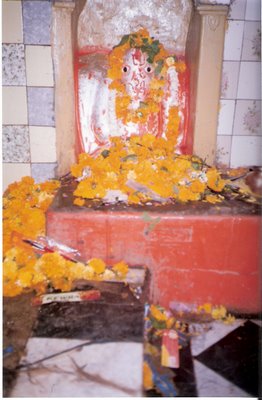
Inside the temple....
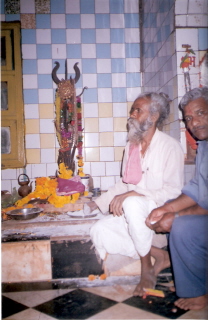

The picture posted above was taken inside the sanctum sanctorum. The shivling can be seen. This is a small space not unlike a cave. Just enough space for 4 or 5 persons to stand. The ambience is awesome. The faith and belief of hundreds and thousands of pilgrims who have come here can be felt. I pay my respects to Shiva - the Hindu God of destruction.

On the way down I can see the lake which is known as Yashwant Nagar Talaab. I have often been there. I have gone through these forests towards the dam and lake on many an occassion. It is a beautiful place.

A group of children accost me. After much persuasion they convince me that I have to click their picture. "If you can't send us the picture you can keep it," they tell me. Their aim is that I must click their picture - that will make them happy. I am convinced. Their mothers who arrive a minute later laugh when I tell them how sweet the kids are. They give me their address. They live in a village named Bagdi. I am stunned by the openness with which they have accepted me. This is what life in villages and small towns is all about. Bagdi is a village which is on the way to the deserted fortress city of Mandu and the district headquartes of Dhar. The village next to it is Agdi. Children love reciting these names. Agdi Bagdi.

Two young boys sit with cobras. Luckily one doesn't see many like them. For each snake which gets captured alive at least four get killed in the attempt to catch them. I wish they had someone who could guide them and create a co-operative like Romulus Whitaker has done for the Irula tribals of Tamil Nadu. As I leave after clicking this picture one of the boys says "Photu to le liya ab kuchch paisa bhi de jao." ("You have clicked the picture you wanted. Now how about a coin or two.")He is a lovable rascal. I give him a rupee. But I am not happy doing it as I do not want to encourage the capture of snakes.

As I reach the base of this hill I pass this pair of trees. I have been seeing them for years. A banyan tree which is climbing on a mahua tree. Many years ago I overheard a lady from a village telling her companions that the mahua tree had taken a loan from the banyan tree in a previous birth. She was repaying the loan in this birth. An interesting story. I remembered it as I saw these trees again.
After walking for a kilometer I realise that I have reached the village and the highway . The car is waiting. I see many more pilgrims begin their climb. It will be very late when they return. But I am tired. Tired and happy. I will be here again next year fifteen days after Diwali. I will be here along with thousands of villagers and I will climb the hill of Janapao with them. This is an annual event and pilgrimage for me and will continue for as long as I can do it.
The day: Kartik Purnima - the first full moon after Diwali. This year the day fell on November 5, Sunday. The temple of Janapao is famous for a mela which is held on Kartik Purnima every year. This is the best time for a mela. It is exactly a fortnight after Diwali. The weather at this time of the year is excellent. Not warm at all. Slightly cold. I have been visiting this hill temple every Kartik Purnima from 1994 onwards. It is a big day in my calendar. It is the day I get to see thousands of villagers from near and far come to this temple to pay obeisance to Lord Shiva and to bathe in the temple pond at the top of the hill.
Janapao, according to local legend, is the place where Jamadagni, the father of Parasurama, lived. As Parasurama, one of the avatars of Vishnu is connected with the mythology of Kerala - the state I originally belong to - I get an actual feel of how mythology connects different parts of India.
The hill of Janapao isn't very high but it isn't an easy hill to climb either. It is supposed to be the second highest hill on the Malwa Plateau. I have come here on normal days too. Sometimes alone and sometimes with groups of trekkers. But nothing equals what I see on Kartik Purnima day. It is an awe inspiring sight to see old men and women climb up the hill barefeet. It is amusing to see young men trying to go as high as possible on their motorbikes. I guess the very idea of a pilgrimage is defeated when one makes the act of reaching there an easy one. Something like going to Vaishno Devi by helicopter.
I drove down till village Kuti on the 5th. I would have preferred reaching there by bus or even by cycling down but social commitments ate up a few hours between breakfast and lunch. And so I had to turn to one of my regular cab drivers for help. Leaving the car at a safe place. I went up the hill. But before that I spent some time at the mela. Savouring the atmosphere and clicking a few pictures. A policeman on duty wanted to know which newspaper I represented. I told him that these pictures were for the internet. I am not sure whether he understood.
The climb up was tough. But the sight of young children and their old grandparents also climbing the same hill motivated me a lot. I was out of breath as I climbed up. But I have learnt how to pace myself. This seems to be something I am getting better at with each passing year.

The village panchayat is out on this day. Arranging the mela with the help of policemen who have been assigned the job of enusring that the mela is held peacefully and the pilgrims complete their pilgrimage without any hitch.

The stretch of the busy Agra Bombay road which passes through the village gets blocked. Trucks loaded with goods have to stop or crawl through the crowds.

A mela without a giant wheel? No way! There is one here too.

One of the many shops selling tea and snacks. The ladoos and jalebis look tasty. But I'd rather not eat them. I go for the biscuits and tea. Much safer.

There are many vendors selling everything from chillies to combs. This young man is sitting with his pile of chillies. I forgot to ask him where he belongs to. In all probability he may have come from the plains of Nimar. Nimar is where the Narmada flows and is famous for the 'jwala mirchi' or 'fire chilly'.

I also see this young man advertising the berries he is selling. "Marwar ke bor" is what I hear him repeatedly saying in a loud voice. He tells me that these are from Marwar, Rajasthan. I remember the ber (berries) we used to pluck outside our house in Itarana Cantonment of the Alwar district of Rajasthan. I buy two rupees worth of ber. Their taste takes me back to my childhood. I continue walking.

Just before the main hill of Janapao is this temple dedicated to Hanuman. I see many villagers and pilgrims pay obeisance. I fold my hands and give my respects. But I do not stay back. I have started late today. It is near 3 pm. I must ascend, spend an hour on top and descend - all before it gets dark.

The climb begins. I have chosen the tougher of two paths. It is an annual ritual now. Since this is a tougher path there are less people on it. I am always wonderstruck at how women, especially old women climb up the hill. Many of them are barefeet. Not for them the costly pairs of trekking shoes and boots. This is something that they and their families must have been doing since many decades, if not centuries.

As I climb up I see groups of pilgrims descending. The common greeting of the Malwa area is 'Ram Ram'. Many I cross greet me thus. Many want to know why I and those who are climbing with me have chosen this path. "The other path is easier to climb," they tell me. But I prefer this path. Call it the path less travelled.

As I climb up I can see lakes formed by small dams in the distance. In this photograph we can see the lake of Golkheda. I have not been there for quiet some time now.

I have reached the top. I see pilgrims buying incense sticks, coconuts and sweets for the prasad before they enter the sanctum sanctorum.

Many, if not most, of the pilgrims take a dip in the pond or kund before they enter the temple. Some even collect the water in mineral water bottles.

People come from near and far. I see this tribal family heading towards the temple. Besides pilgrims from Dhar and Dewas I have also met pilgrims from Akola and Nagpur in Maharashtra. Indore and Nagpur used to be parts of Central India during the British days so it is not surprising to see people from these areas here.

Devotees worshipping a lingam outside the sanctum sanctorum.

Inside the temple....


The picture posted above was taken inside the sanctum sanctorum. The shivling can be seen. This is a small space not unlike a cave. Just enough space for 4 or 5 persons to stand. The ambience is awesome. The faith and belief of hundreds and thousands of pilgrims who have come here can be felt. I pay my respects to Shiva - the Hindu God of destruction.

On the way down I can see the lake which is known as Yashwant Nagar Talaab. I have often been there. I have gone through these forests towards the dam and lake on many an occassion. It is a beautiful place.

A group of children accost me. After much persuasion they convince me that I have to click their picture. "If you can't send us the picture you can keep it," they tell me. Their aim is that I must click their picture - that will make them happy. I am convinced. Their mothers who arrive a minute later laugh when I tell them how sweet the kids are. They give me their address. They live in a village named Bagdi. I am stunned by the openness with which they have accepted me. This is what life in villages and small towns is all about. Bagdi is a village which is on the way to the deserted fortress city of Mandu and the district headquartes of Dhar. The village next to it is Agdi. Children love reciting these names. Agdi Bagdi.

Two young boys sit with cobras. Luckily one doesn't see many like them. For each snake which gets captured alive at least four get killed in the attempt to catch them. I wish they had someone who could guide them and create a co-operative like Romulus Whitaker has done for the Irula tribals of Tamil Nadu. As I leave after clicking this picture one of the boys says "Photu to le liya ab kuchch paisa bhi de jao." ("You have clicked the picture you wanted. Now how about a coin or two.")He is a lovable rascal. I give him a rupee. But I am not happy doing it as I do not want to encourage the capture of snakes.

As I reach the base of this hill I pass this pair of trees. I have been seeing them for years. A banyan tree which is climbing on a mahua tree. Many years ago I overheard a lady from a village telling her companions that the mahua tree had taken a loan from the banyan tree in a previous birth. She was repaying the loan in this birth. An interesting story. I remembered it as I saw these trees again.
After walking for a kilometer I realise that I have reached the village and the highway . The car is waiting. I see many more pilgrims begin their climb. It will be very late when they return. But I am tired. Tired and happy. I will be here again next year fifteen days after Diwali. I will be here along with thousands of villagers and I will climb the hill of Janapao with them. This is an annual event and pilgrimage for me and will continue for as long as I can do it.


10 Comments:
interesting...please post the remaining part soon!
Hi vi. I have managed to upload the remaining photographs in the same blog entry. So I have done away with part one and part two. Hope you like this complete blog post.
Thanks for sharing really interesting journey!
vi
thanks dev for again giving me some idea of your life, a yearly pilgrimage sounds fulfilling spiritually, especially one in such a beautiful place, so colorful and lush and i'm intrigued by the picture of the little boys with cobras...
Dev,
Terrific post and thanks for such a vivid image of the Kartik Purnima Mela!
Was it not Gandhi(ji) who wrote India lives in its villages?
Warmly,
Shri.
Glad you liked this post Shri.. how about us climbing Janapao the next time you are in Mhow?
dev,
ur photographs look so real,u have breathed life into them.great it tempts me to visit the place..great work
Hi
I was looking for other links on the banyan tree at Beirchaa lake, and came across several of your entries.
Was happy to visit MHOW and its quite environs.
Hi swarna... it has been great reading your blog posts... am glad you visited mhow :))) regards... dev (01 feb 2009)
For all people is an important part of travel. It's a good place to travel around and do not like. I traveled to India for all information such as, we let you know more, click on madhyapradesh …
Post a Comment
<< Home